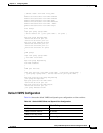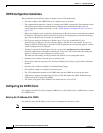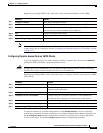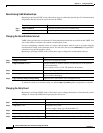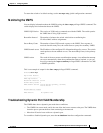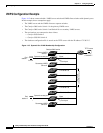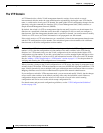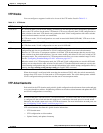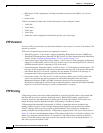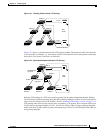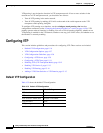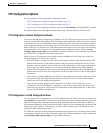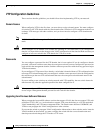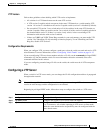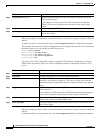
15-3
Catalyst 2950 Desktop Switch Software Configuration Guide
78-14982-01
Chapter 15 Configuring VTP
Understanding VTP
VTP Modes
You can configure a supported switch to be in one of the VTP modes listed in Table 15-1.
When the network is configured with more than the maximum 250 VLANs, the switch automatically
changes from VTP server or client mode to VTP transparent mode. The switch then operates with the
VLAN configuration that preceded the one that sent it into transparent mode.
VTP Advertisements
Each switch in the VTP domain sends periodic global configuration advertisements from each trunk port
to a reserved multicast address. Neighboring switches receive these advertisements and update their VTP
and VLAN configurations as necessary.
Note Because trunk ports send and receive VTP advertisements, you must ensure that at least one trunk port
is configured on the switch and that this trunk port is connected to the trunk port of a second switch.
Otherwise, the switch cannot receive any VTP advertisements. For more information on trunk ports, see
the “Configuring VLAN Trunks” section on page 14-15.
VTP advertisements distribute this global domain information:
• VTP domain name
• VTP configuration revision number
• Update identity and update timestamp
Table 15-1 VTP Modes
VTP Mode Description
VTP server In VTP server mode, you can create, modify, and delete VLANs and specify other configuration parameters
(such as the VTP version) for the entire VTP domain. VTP servers advertise their VLAN configurations to
other switches in the same VTP domain and synchronize their VLAN configurations with other switches
based on advertisements received over trunk links.
In VTP server mode, VLAN configurations are saved in nonvolatile RAM (NVRAM). VTP server is the
default mode.
VTP client A VTP client behaves like a VTP server, but you cannot create, change, or delete VLANs on a VTP client.
In VTP client mode, VLAN configurations are not saved in NVRAM.
VTP transparent VTP transparent switches do not participate in VTP. A VTP transparent switch does not advertise its VLAN
configuration and does not synchronize its VLAN configuration based on received advertisements.
However, in VTP version 2, transparent switches do forward VTP advertisements that they receive from
other switches from their trunk interfaces. You can create, modify, and delete VLANs on a switch in VTP
transparent mode. The switch must be in VTP transparent mode when you create extended-range VLANs.
See the “Configuring Extended-Range VLANs” section on page 14-12.
When the switch is in VTP transparent mode, the VTP and VLAN configurations are saved in NVRAM,
but they are not advertised to other switches. In this mode, VTP mode and domain name are saved in the
switch running configuration and you can save this information in the switch startup configuration file by
entering the copy running-config startup-config privileged EXEC command.



